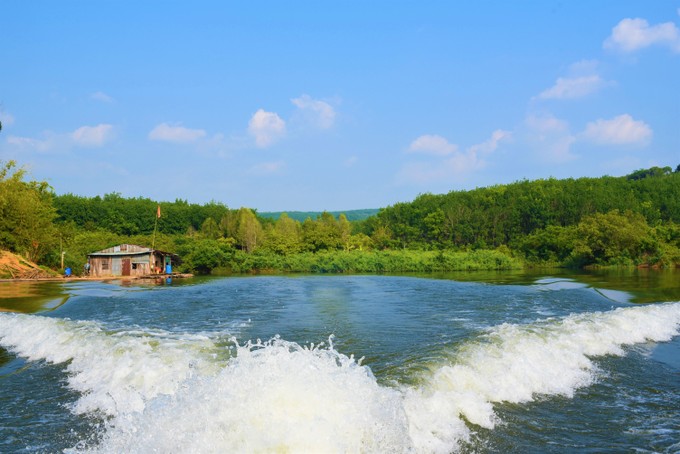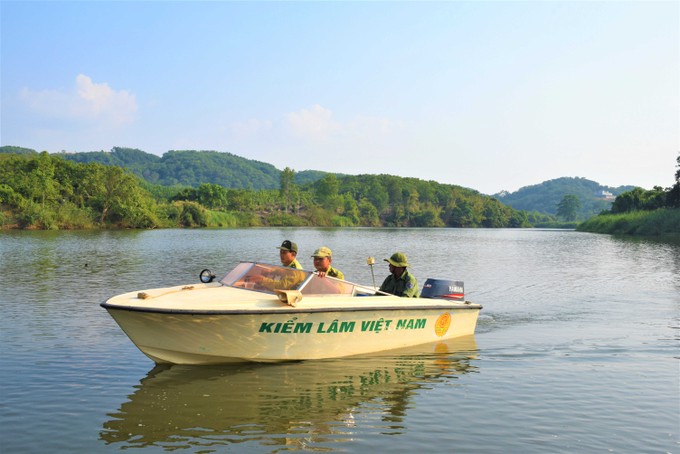Strict protection of upstream forests plays a crucial role in regulating water for hydroelectric plants, fostering rich aquatic life, and awakening the potential for eco-tourism resources step by step.

Bu Gia Map National Park hosts more than 400 animal species, 30 of which are listed in the Red Book.
The Be River stretches 350km, beginning in the Central Highlands province of Dak Nong and flowing downstream through Binh Phuoc and Binh Duong provinces before merging into the Dong Nai River at Hieu Liem Commune, Vinh Cuu District, Dong Nai Province. Strict protection of its upstream forests plays a crucial role in regulating water for hydroelectric plants, fostering rich aquatic life, and awakening the potential for eco-tourism resources step by step.
After flowing approximately 32km past the Thac Mo Hydroelectric Plant, the Be River meets the Dak Huyt River along the Vietnam-Cambodia border at the Vam intersection (Thanh Hoa Commune, Bu Dop District, Binh Phuoc Province). It changes direction several times before continuing downstream. The upper reaches of the Be River include the Bu Gia Map National Park, covering over 25,600 hectares. It supplies water to hydroelectric reservoirs and provides stable employment opportunities for local ethnic minorities such as the Stieng and Mnong.
A life for the forest
We were driven by a pickup truck along a challenging road of more than 10km, passing through dusty red dirt sections, winding hills, and sharp bends. After navigating steep inclines and deep pits, we arrived at the inter-agency checkpoint in the Can Don Lake basin in Sub-zone 52, Dak O Commune, Bu Gia Map District. This checkpoint is managed by the Dak Mai Forest Protection Management Board under the Department of Agriculture and Rural Development of Binh Phuoc Province. The checkpoint is a simple wooden structure with a corrugated iron roof, situated along the riverbank, providing shelter from rain and sun for the forest rangers after their patrols.

The forest ranger checkpoint at the Can Don Lake basin
Accompanied by the rangers, we embarked on a canoe trip along the winding 20km of Dak Huyt River. The river's narrow and meandering path is flanked by dense growths of buttonbush (Cephalanthus tetrandra), resin tree (Dipterocarpus alatus), Sassafras albidum, and Terminalia chebula, creating a lush green tapestry along the banks.
Ta Dinh Trung, 57, a forest ranger with 36 years of experience in forestry, shared that he spends most of his time in the forest rather than at home. He eats, sleeps, and lives at a checkpoint with three other rangers to protect the headwaters forest along the Dak Huyt River. Each week, they assign specific tasks and take turns patrolling to safeguard the forest. Thanks to their dedicated efforts, illegal logging and hunting have significantly decreased in the rugged upper reaches of the area.
Living secluded in the forest, Trung and his colleagues are largely cut off from the outside world. Communication via mobile phones is sporadic, and they stockpile rice, fish sauce, salt, and filtered water to sustain themselves for weeks or even months. Their profound love for the forest enables Trung and his colleagues to overcome challenges and quietly fulfill their roles as steadfast guardians amidst the ancient woods.
Upon reaching the Dak Mai Forest Protection Management Board, we met Hoang Hong Son, 57, who oversees operations for the board and has dedicated 25 years to forest conservation. He shared his experiences: In the early 2000s, managing and protecting the forest posed significant challenges due to frequent raids by logging groups. These groups would harvest timber and float it downstream along the Dak Huyt River, where their accomplices waited to transport and sell it. Illegal loggers from Dak Nong also regularly ventured in, using buffalo-drawn carts to haul timber. During one interception, when forest rangers intervened, the unlawful loggers gathered 30-40 individuals armed with machetes and knives, engaging in a fierce confrontation to reclaim their seized goods. Despite the aggressive tactics of the loggers, Son and his colleagues remained steadfast. They enhanced their vigilance, tightened disciplines, and strengthened their unity, resolutely pursuing those who posed threats to the forest.
The Dak Mai Forest Protection Management Board emphasizes awareness campaigns to enhance forest conservation efforts. Together with local households, they commit to preserving every inch of forest and ensuring no further encroachment or deforestation occurs.
Dieu Sa Riu, 40, from the Stieng ethnic group in Bu Gia Map Commune, has been actively involved in forest protection for over 16 years. He said, "I am delighted that the S'tieng and M'Nong people have learned from forest rangers and border guards about what is right and wrong, so we no longer destroy the forest. I have a son who loves the forest as much as I do. He passed the exam to become a forest ranger and now works alongside our community, border guards, and forest rangers in safeguarding our forests."
According to Mr. Nguyen Tien Phong, Director of the Dak Mai Forest Protection Management Board, the unit oversees 20,796.62 hectares of forestry land, including 11,313.07 hectares of protected forests spread across Dak O, Bu Gia Map, and Phu Nghia communes, contributing to restoring and developing forests, conserving biodiversity, and providing environmental services.
Although the area is characterized by challenging terrain, separated by numerous rivers, streams, and large lakes, and local ethnic minorities traditionally practice slash-and-burn agriculture, these obstacles have not discouraged the forest rangers. On the contrary, they are more determined than ever to protect the forests wholeheartedly within the managed forest area.
Life improvement through forest protection stewardship
Following the forest rangers of Bu Gia Map National Park, we delved deep into the forest. Despite the intense heat of the dry season, the air felt surprisingly cool, fresh, and pleasant. Vast expanses of pristine forest unfolded before us, showcasing a variety of valuable timber trees, some towering as high as 30 meters, with large tree trunks and vines intricately entwined around them. Upon inquiry, we discovered that this area is home to ten communities comprising over 620 households, predominantly Stieng and Mnong ethnic minorities. These communities in Dak O and Bu Gia Map communes in Bu Gia Map District and Quang Truc Commune in Tuy Duc District of Dak Nong Province manage and protect 19,000 hectares of forest through stewardship agreements. The forest has significantly contributed to stabilizing the livelihoods of these communities compared to before.

The forest rangers of the Dak Mai Forest Protection Management Board patrol the forest along the Dak Huyt River, at the headwaters of the Be River.
At just past 7 a.m., morning sunlight streamed through the leafy canopy, casting a glow over the entire forest. Dieu Ton, 47, a member of the forest protection team in Bu Dot Hamlet, Bu Gia Map Commune, rode his motorbike into the forest with bulky equipment, diligently clearing twigs, leaves, and dry grass along the firebreak. He elaborated, 'Our team comprises 36 members, working in shifts around the clock to safeguard over 2,000 hectares of forest. Given the persistent threat of forest fires, we rotate duties rigorously to remain vigilant. Outside of patrol hours, community members also pick cashews and collect rubber latex, earning over VND10 million per month, ensuring our livelihoods.'
Looking at the thriving patches of pristine forest, Dieu Ton emphasized the importance of treasuring the forest because it sustains the livelihoods of the Stieng people. During patrols and monitoring, along with promoting awareness and mobilizing communities to follow forest and wildlife protection regulations strictly, the stewardship team has repeatedly detected and apprehended individuals engaging in illegal activities such as hunting, trapping animals, fruit picking, and unauthorized logging in the forest, and then handed them over to national park authorities for appropriate action.
Under the scorching sun, Dieu Long, 53, from Dak A Hamlet, Bu Gia Map Commune, diligently patrols the forest along the Cambodian border. Taking a sip of water to ease his thirst, Long shared that he was born and raised in the ancient forest within a poor Stieng ethnic family. At just 14 years old, he ventured into the forest to make a living, starting with hunting wild animals and later engaging in illegal logging and clearing land for farming. After years as an illegal logger, he had a profound realization upon witnessing the forest's devastation and the worsening conditions for his community. Reflecting on the idea that 'if each person cuts down one tree, then a thousand people will lose a thousand trees, and the forest will disappear,' Long decided to dedicate himself to forest protection to repay his debt to nature in 2006. With an average monthly income of VND2-2.5 million, he earns VND8-10 million quarterly. He also encourages fellow Stieng people to abandon slash-and-burn farming and wildlife hunting to protect the forest and sustain their way of life.
We met with Mr. Hoang Anh Tuan, Deputy Director of the Bu Gia Map National Park Management Board, who has been with the park since its inception and knows every path, river, and stream. He shared that the park, covering over 25,600 hectares, is considered the "green lung" of the Southeast region, safeguarding the headwater forests for the reservoirs of the Thac Mo, Sork Phu Mieng, and Can Don hydropower projects. Over the past 22 years, the park's staff, employees, and rangers have faced many challenges to protect the forest, resulting in significant decreases in illegal logging and wildlife hunting. Notably, since the park's establishment, there have been no cases of forest clearance for farming within its boundaries, effectively preventing illegal land encroachment and preserving the natural forest area intact.
Bu Gia Map National Park is home to 1,117 plant species, including rare and valuable legumes such as Dalbergia oliveri, Afzelia xylocarpa, Pterocarpus macrocarpus, Aquilaria crassna, Nageia fleuryi, along with 278 medicinal plants and more than 400 animal species, 30 of which are listed in the Red Book. Bu Gia Map National Park contributes to biodiversity conservation and supports scientific research, environmental education, and eco-tourism development. The park is also finalizing documentation to propose UNESCO recognition as Vietnam's 12th World Biosphere Reserve.
By Hoang Bac, Xuan Trung, Bui Liem - Translated by Thuy Doan